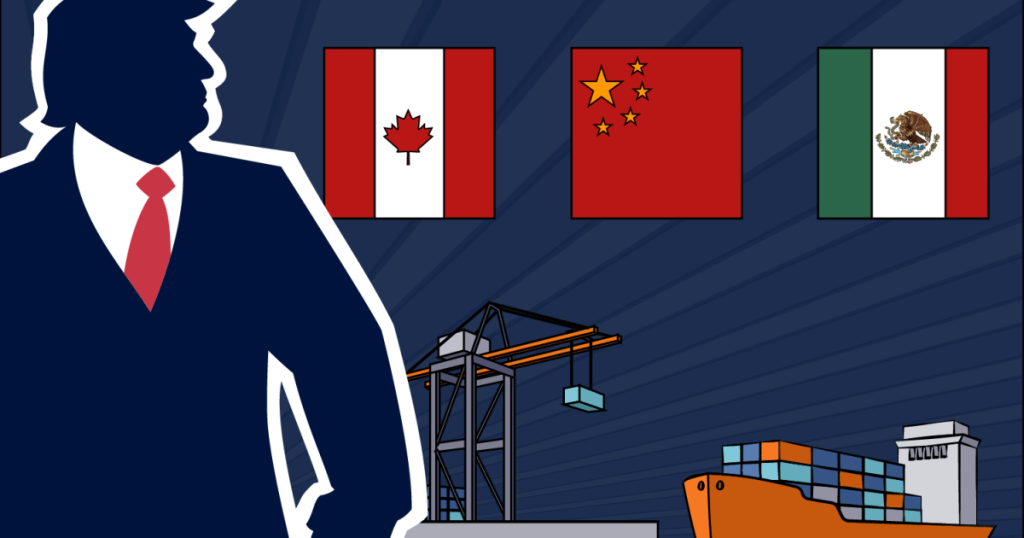The United States, under the Trump administration, initiated a series of tariff measures targeting imports from Canada, Mexico, and China, sparking concerns about a potential global trade war and its economic repercussions. These tariffs, essentially taxes on imported goods, were designed to protect domestic industries, discourage reliance on foreign products, and generate revenue for the government. While the planned 25% tariffs on Canadian and Mexican goods were temporarily postponed following high-level discussions and commitments on border security, the 10% tariffs on Chinese goods went into effect, escalating trade tensions with Beijing. This move prompted retaliatory measures from China, further complicating the already intricate web of global trade relationships.
Tariffs operate by increasing the cost of imported goods, making them less competitive compared to domestically produced alternatives. This price difference is intended to incentivize consumers to purchase American-made products, thereby boosting domestic industries and potentially creating jobs. For instance, if a Chinese manufacturer sells a pair of jeans to a US importer for $10, and a 10% tariff is imposed, the importer pays an additional $1 to the US government. This added cost is typically passed on to the consumer through higher retail prices. However, the effectiveness of tariffs in achieving their intended goals is often debated, with some arguing that they primarily harm consumers through increased prices and can trigger retaliatory tariffs from other countries, ultimately hindering economic growth.
The temporary reprieve on tariffs for Canada and Mexico followed direct engagement between President Trump and the leaders of both countries. Mexico agreed to deploy 10,000 soldiers to its border with the US to address migration concerns, while Canada pledged to strengthen its border security measures, appoint a “fentanyl czar,” and designate certain cartels as terrorist organizations. While this pause provided a temporary relief from escalating trade tensions, it highlighted the underlying issues of border security, drug trafficking, and economic interdependence between the US and its North American neighbors. Experts emphasized the need for long-term solutions beyond immediate crisis management, including diversifying trade relationships and investing in domestic competitiveness to reduce reliance on the US market.
The use of tariffs is not a novel concept. Historically, tariffs have served as a significant source of government revenue, particularly in the early years of the United States. They have also been employed as a tool to address unfair trade practices or penalize countries deemed to be violating international trade rules. The Trump administration’s justification for imposing tariffs stemmed from several factors, including curbing illegal immigration, stemming the flow of illicit drugs like fentanyl, revitalizing domestic manufacturing, and encouraging foreign companies to relocate their production facilities to the US. While tariffs can generate revenue, as evidenced by the increase in tariff revenue during Trump’s first term, the burden of these increased costs is often borne by consumers through higher prices.
The range of products impacted by the tariffs is extensive, encompassing key imports from Canada, Mexico, and China, such as automobiles, fuel, electronics, and agricultural produce. The specific tariffs proposed included a 25% levy on all goods from Canada and Mexico, a 10% tariff on Canadian oil, and an additional 10% tariff on Chinese goods. These tariffs targeted sectors crucial to the economies of all countries involved, raising concerns about disruptions to supply chains, price increases, and potential economic instability. The threat of retaliatory tariffs from Canada, Mexico, and China loomed large, potentially escalating the trade dispute into a full-blown trade war with far-reaching global consequences.
The potential for a trade war, triggered by escalating tariffs and retaliatory measures, poses significant risks to the global economy. Increased prices for consumers, disruptions to supply chains, and decreased international trade are among the potential negative consequences. The prospect of a trade war also raises concerns about inflation, as higher import costs are often passed on to consumers. While consumers can mitigate some of the impact by opting for domestically produced goods, the overall inflationary pressure from a trade war is difficult to avoid. Furthermore, businesses, particularly those involved in international trade, face increased costs and potential market disruptions, further exacerbating economic uncertainty. The long-term effects of a trade war can be detrimental to global economic growth and stability, underscoring the need for diplomatic solutions and cooperation to resolve trade disputes.

